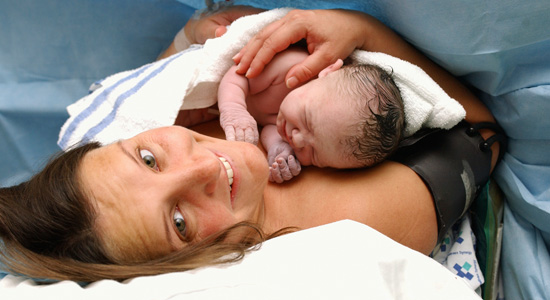
By Bob Gulla
The woman I love lies before me, about to give birth to our child. She is in obvious distress as we near the moment of truth. There is much sweat and gnashing of teeth. She is in a very compromising position, and unfamiliar people bustle about the room. So what do I do? Like all good and sensitive husbands, I encourage her to do one thing: “Smile, honey!” I lean in and snap a picture, flash and all. OK, honestly, I didn’t actually do that.
This is not to say that the delivery room isn’t a place for photography. In fact, the experience provides a critical backdrop for some very valuable pictures. “Our first family shots with the three of us all together were taken in the delivery room,” says Melissa Moody, a new mom from Mountain View, CA. “If I didn’t have those pictures, I’d be devastated.”
Fortunately, in our digital world, getting those images is quicker and easier than ever. Bill Camann, M.D., director of obstetric anesthesiology at Brigham and Women’s Hospital in Boston and co-author of Easy Labor, has become something of an expert on photography during and after the actual birth. “Digital cameras have changed the delivery-room experience. With C-sections, especially, the first time the mother sees her baby is usually on the screen of a digital camera. And dad can actually have the baby’s picture on the Internet before mom is all sewn up.”
Cameras in the delivery room might be ubiquitous, but taking quality pictures is another story. Tensions can run high, the lighting isn’t ideal, and the bustle of activity makes snapping any real keepers a challenge for the best photographer.
Melissa Moody’s husband, Brian, went in with a plan and a nice new digital SLR camera around his neck, but was soon ordered by the head nurse to “grab a leg.” Melissa recalls, laughing, “He was white as a sheet. He had his camera around his neck, but he wasn’t taking any pictures!”
Certainly, there is a time and place for photos in the delivery room. But the most important thing to remember is that the room itself will be a very busy and crowded place, and you will be engaged caring for your partner. There will be precious little time to take photographs, and when you do take them, they will be more like what a war correspondent might get on the job.
“I was holding a leg,” remembers one dad. “I was consumed with being in the moment. I didn’t want to be snapping pictures. I wanted to be there, not weighed down by a camera.”
If you’re concerned about the idea of taking pictures in the delivery room, here are some things to consider:
- The delivery room is illuminated by a combination of tungsten and fluorescent lighting. If you’re slated to deliver by C-section, the operating room will be plenty well lit, making a flash unnecessary. In vaginal deliveries, the birthing rooms are a little darker, rather small, and the shooting range will likely be about 5 to 6 feet. During the delivery experience, a safe film speed is 400 or 800. You can use a slower setting, or even a small tripod, when the commotion subsides and relatives and siblings enter the picture.
- Even then, Camann explains, you should give particular deliberation to those intimate family portraits. “Let’s say the mom or dad is sitting there holding the baby. Well, they usually look down at the baby, which doesn’t make for a great photo. Have the parents look up and at the camera. Also, the babies are often swaddled so much that only a little sliver of face is showing. Loosen it up a little, or at least make sure that the camera angle picks up the baby’s face.”
- And, of course, make sure you shoot lots and lots of pictures of the new mother. Chances are she’ll be ready with a big, beautiful smile.
- Even then, Camann explains, you should give particular deliberation to those intimate family portraits. “Let’s say the mom or dad is sitting there holding the baby. Well, they usually look down at the baby, which doesn’t make for a great photo. Have the parents look up and at the camera. Also, the babies are often swaddled so much that only a little sliver of face is showing. Loosen it up a little, or at least make sure that the camera angle picks up the baby’s face.”
More tips for delivery-room photographers:
• Check your hospital’s policy. Some won’t allow flash photography, and some don’t allow cameras at all. Sometimes the decision is left up to the obstetrician.
• Make a prenatal hospital visit and envision your task before it happens. Check the lighting, the space, and the possible angles of photography.
• Make a checklist of photos you want to get and stick to it, no matter how stressed you feel.
• If possible, take the moment of delivery.
• Consider taking photos in black and white. There’s timelessness about them and it eliminates the unflattering color palette—pale mom, ruddy baby, ashen dad—of the experience.
• Other essential shots you might not consider:
– The hospital room
– The clock showing time of birth
– Baby on the scale
– The nurses and medical staff
– Some people actually photograph the placenta!
• Take more pictures than you’ll need. You can always delete them, but you can never recreate that moment.
Bob Gulla has been at his wife’s side for all four of his kids’ deliveries—two in the harsh light of the operating room. Oddly, he didn’t take pictures at any of them. In hindsight he’s disappointed, but glad that his pasty gaze and dark, encircled eyes were left undocumented.


Leave a Reply